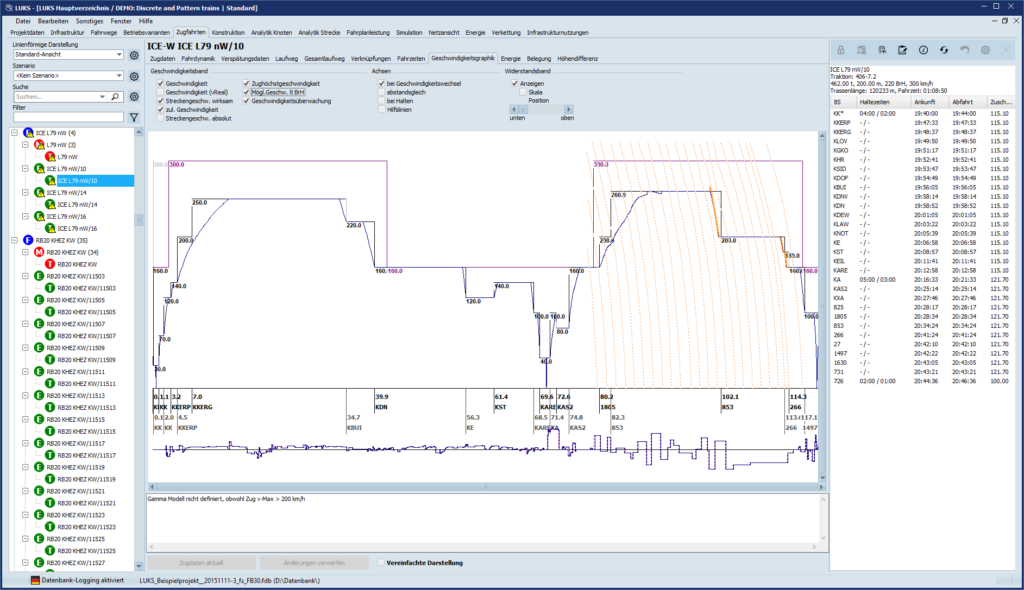LUKS-Basis (Functionalities)
The basic module includes all elementary and project-forming functionalities such as the import and export of various data and data formats, the management of projects, track plans, and master data, detailed travel time and occupancy calculations on train data, differentiated conflict detection and elementary energy calculations.
LUKS-K (Construction)
The LUKS-K module supplements the basic recording and maintenance of train data with a wide range of high-performance functions for interactive, graphical timetable fine-tuning. Train journeys, the exact occupancy of the infrastructure in the form of blocking times and any conflicts between journeys are detected and displayed in a graph. This allows the timetable to quickly be checked for conflicts, free capacity to be identified, and bottlenecks to be analyzed interactively. The module is rounded off with different structuring and aggregation approaches such as operating variants, scenarios, train families, model trains and more, as well as the editing of train lines with interactive calculations and the display of blocking times, occupancy and routes in various diagrams, and visualizations such as time-distance lines, image timetables, track occupancy plans, flow and traffic graphs or animation of the current planning.
LUKS-A (Analytical)
The LUKS-A module is based on analytical methods (queueing theory) in order to obtain general statements about the utilization of infrastructure areas or altered behavior with increased utilization of individual relationships.
The analytical approach has the advantage that bottlenecks in the infrastructure or heavily used areas/track groups can be identified relatively quickly and at a more abstract level. The uncertainties of future developments and operating programs are mapped using long-term approaches such as daily timetables, delay distributions and operating programs. A characteristic feature of this analytical approach is that it is also possible to consider train volumes and mixes independently of timetables.
LUKS-S (Simulation)
The LUKS-S module supplements LUKS® to include the simulation of timetable creation as well as the simulation of operations with randomly interspersed disruptions and the resulting scheduling and rescheduling processes. In all situations, any resulting effects and subsequent delays on other train journeys are taken into account.
Using synchronous and asynchronous components, the simulation allows key figures for the robustness and capacity of given timetables to be determined. Synchronous components are used to simulate train movements and interlocking behavior along a model system time, while asynchronous components implement the scheduling and rescheduling functionalities.
LUKS-OptDis (Timetable Opt.)
The LUKS-OptDis module supplements LUKS® with the overall optimization of any timetable. It supports the user in the time-consuming manual creation of microscopic timetables with the following automatic functions: resolution of all occupancy conflicts, fulfillment of all cycle times and connections as well as maximization of buffer times and travel time reserves. OptDis is fully integrated into LUKS®, i.e. all input data and the results of the optimization can be edited and reused with the usual editors.
LUKS-C (Capacity)
The LUKS-C module expands the suite with functions for evaluating the current and available capacity in accordance with UIC Leaflet 406, “Capacity”. Based on a timetable provided by LUKS-K, the interlinking approach can be carried out for several examination and assessment areas, time windows, and under different parametric configurations. LUKS-C therefore represents a generic toolbox that implements the chaining approach but offers great flexibility in the definition of infrastructure manager-specific properties and rules.
LUKS-ISN (Infrastructure Utilization)
The LUKS-ISN module calculates key figures for the utilization of the various infrastructure elements on the basis of the train journeys outlined in the timetable. For example, the daily utilization of switches can be described by various parameters such as the number of trains, weight of trains, or the number of position changes. In this way, maintenance strategies can be adapted to the actual utilization of infrastructure areas.

